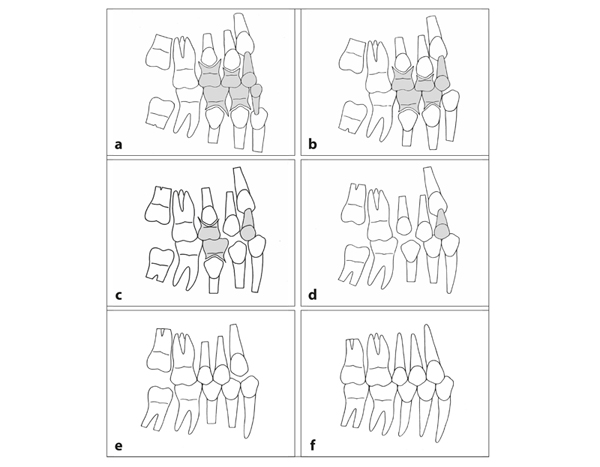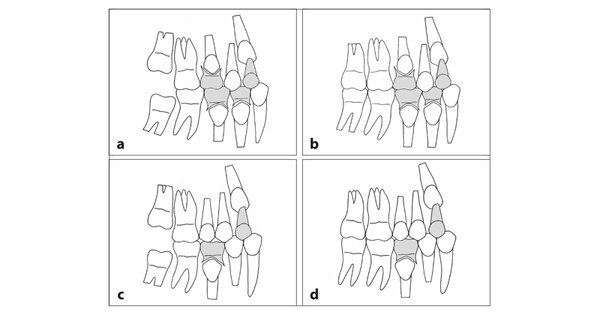CHAPTER 5
The Second Transitional Period: Transition of Canines and Deciduous Molars/Premolars and Emergence of Second Permanent Molars
Emergence Sequence
The second transitional period lasts 1 to 1.5 years. At about 10 years of age, 2 years after the emergence of the maxillary lateral permanent incisors, the first tooth, usually a mandibular deciduous canine, is shed. In contrast to the predictable emergence sequence of the permanent incisors, a large variation exists in the sequence of emergence of permanent canines and premolars. The spatial conditions in the anterior region allow only one eruption sequence for incisors. There is more space for the not-yet-emerged permanent teeth in the buccal region, and they can be arranged with space in between. However, the maxillary permanent canine is often situated close to and above the first premolar, in which case the premolar emerges first. The distal corner of the canine lies next to the first premolar at the junction of its crown and root. The maxillary first premolar has a corresponding concavity at its mesial side. The second premolar has no such concavity and not two roots but only one; otherwise, the crowns of the premolars are alike in shape and size.
The most common sequence of emergence in the mandible is: canine, first premolar, second premolar; in the maxilla: first premolar, second premolar, canine1 (Fig 5-1). In both jaws, the first two mentioned teeth quite often emerge at the same time or shortly after one another. In the mandible, all possible variations in sequence of emergence can occur. In the maxilla, the first premolar generally precedes the canine. For the frequency of various sequences of emergence3–6 and also for times of emergence7,8 and other statistical data, see chapter 17.
Fig 5-1 Transition in the buccal region and emergence of the second permanent molars. (a) In the maxilla, the first premolar is the closest to the occlusal plane; the canine is the farthest away. In the mandible, the permanent canine is also initially farther away from the occlusal plane than the first premolar (see chapter 3, Fig 3-1). In contrast to the situation in the maxilla, there is some space between these two teeth. Usually there is—although not in this drawing—a flush terminal plane of the deciduous dentition.2 In the maxilla, the canine and first premolar are slightly mesially inclined. (b) Some weeks after the loss of the mandibular deciduous canine, its successor emerges with sufficient space in the dental arch and passes the first premolar while erupting. In the maxilla, the erupting first premolar has come free of the canine crown. (c) In both jaws, the first premolars emerge with sufficient room. (d) Subsequently, the second premolars emerge with excess space in the dental arch. ((e) In the maxilla, the deciduous canine is the last tooth to be lost, and its successor will erupt a few weeks later. The diastemata present, including the central one, provide extra space for the large permanent canine crown. (f) After occlusion has been established, the mandibular second permanent molar is mesially angulated and lingually inclined; the maxillary second molar is distally angulated and buccally inclined.
There is a large variation in the age at which permanent teeth emerge. There is a range of 3 years for the incisors and 6 years for the canines and premolars. Sequences and times of emergence can differ between the left and right sides. Furthermore, the transition in the mandible precedes that in the maxilla. Generally, the second permanent molars erupt when all deciduous teeth, with the exception of the mandibular second deciduous molar, have been replaced (Fig 5-2).
Fig 5-2 Variations in patterns of transition. (a) The mandibular permanent canine and the maxillary first premolar have emerged, but the second permanent molars are not yet emerged. The terminal plane of the deciduous dentition has a mesial step. The first permanent molars occlude optimally. (b) The second permanent molars have emerged. The terminal plane has a small mesial step. The occlusion of the permanent molars is not optimal. (c) Simultaneous emergence of the mandibular permanent canine and first premolar and both maxillary premolars. The second permanent molars have not emerged yet. The wide mandibular second deciduous molar interferes with optimal occlusion of the first permanent molars. (d) The second permanent molars occlude prior to the conclusion of the transition. After loss of the mandibular second deciduous molar, the occlusion of the permanent molars can improve.
Leeway Space
Deciduous molars have mesiodistally larger crowns than do their successors. The reverse holds true for canines. Permanent canines are broader than their predecessors, particularly in the maxilla, and more in boys than in girls. The extra space needed for their replacement is usually available because of the presence of diastemata.
Premolars are located between and below (in the mandible) or above (in the maxilla) the roots of the deciduous molars. After emergence, the mandibular premolars are oriented nearly perpendicular to the occlusal plane. The maxillary premolars are slightly buccally inclined, and the first premolar is mesially angulated. The difference in inclination between first premolars and incisors is greater in the maxilla than in the mandible because the maxillary incisors are much more labially inclined than are the mandibular incisors (see chapter 7, Figs 7-3 and 7-4).
In this context, the term leeway space, introduced by Nance in 1947, should be mentioned.9 Leeway space refers to the difference between the combined widths of the deciduous canine and first and second molars and that of their successors. According to Nance, the average difference for a maxillary quadrant is 1.0 mm and for a mandibular quadrant 1.7 mm (see chapter 17, Fig 17-10). However, there is a large range for these values. The leeway space offers, together with the remaining diastemata, the extra space needed for good alignment of the canines and premolars in the dental arch. With excess space, the first permanent molars can move mesially, especially in the mandible, resulting in improved intercuspation.
Size of the Middle Section of the Apical Area
The sequence of emergence is related to the size of the middle section of the apical area. If it is large, all sequences of emergence can occur (Fig 5-3). However, the mandibular second premolar almost always emerges last in accordance with its late formation. In a medium middle section of the apical area, th/>
Stay updated, free dental videos. Join our Telegram channel

VIDEdental - Online dental courses




